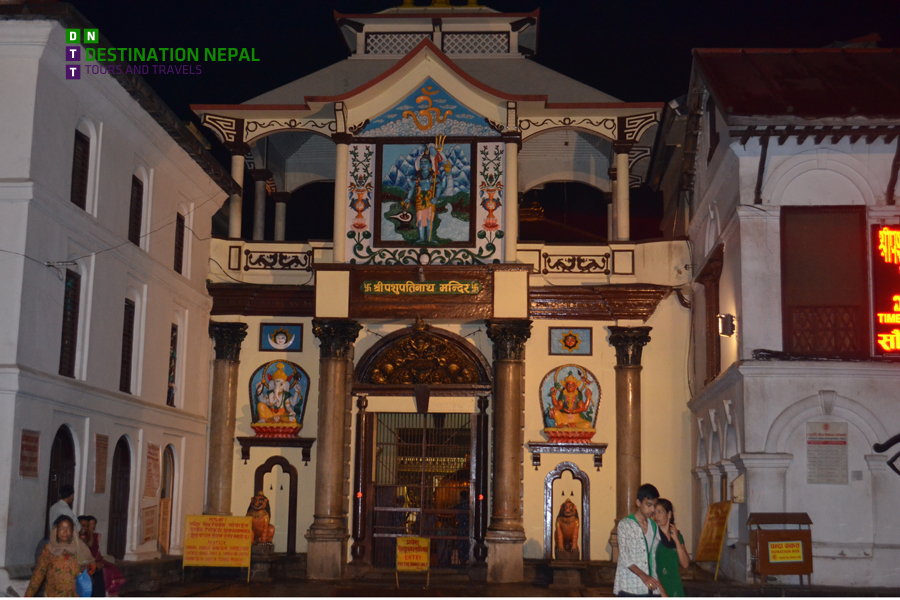Pashupatinath Temple


Pashupatinath Temple, located 5 km east of Kathmandu city center, is one of the most revered Hindu pilgrimage sites in the world and a UNESCO World Heritage Site. Dedicated to Lord Shiva, known as the “Lord of Animals,” the temple holds immense spiritual significance for Hindus. It is a site of profound religious devotion, historical importance, and architectural grandeur, drawing thousands of pilgrims and tourists every year.
The temple is designed in the traditional pagoda style, with a two-tiered golden roof and intricately carved silver doors, epitomizing Nepal’s artistic heritage. At its core lies the Jyotirlinga, a sacred phallic idol of Lord Shiva, symbolizing his presence and cosmic power. The idol has five faces—four representing the cardinal directions and one facing upward—each symbolizing different aspects of Shiva and the universe.
According to legends, the temple's origin is divine. One story tells of a cow that mysteriously offered milk at a specific spot, revealing a self-emerging Jyotirlinga beneath the ground. This discovery marked the location as sacred, and a temple was constructed by Lichchavi King Supushpa Verma. The current structure was later rebuilt in 1697 AD by King Bhupatindra Malla, blending historical architecture with spiritual lore.
Another tale connects the temple to the Pandavas from the epic Mahabharata. Seeking absolution for their sins after the great battle, they found Shiva at this very spot, making it one of the holiest abodes of the deity. It is said that a pilgrimage to the four dhams of India—Dwarika, Kedarnath, Rameshwar, and Jagannath—attains true fulfillment only after visiting Pashupatinath Temple.
The temple complex spans a large area, housing numerous smaller shrines dedicated to various Hindu deities, such as Bhairavnath, Vasuki Nag, Parvati, and Gorakhnath. These structures enrich the spiritual ambiance of the area, making it a hub for meditation, prayer, and rituals. The sacred Bagmati River flows alongside the temple, considered holy by Hindus. Many devotees take ritual baths in its waters, believing it cleanses sins and grants spiritual liberation.
Behind the temple lies a cremation ground, an essential part of Hindu rites of passage. It is believed that being cremated here, on the banks of the Bagmati River, ensures salvation and liberation from the cycle of rebirth. The temple grounds also include a deer park, symbolizing Shiva’s connection to all living beings.
Adding to the temple's unique environment are Sadhus (ascetics) smeared with ashes, Brahmin priests offering blessings, and monkeys freely roaming the premises. Together, these elements create a vibrant and mystical atmosphere that leaves a lasting impression on every visitor.
Key Highlights of Pashupatinath Temple
-
Architectural Significance
The temple's iconic pagoda-style design, golden roof, and exquisitely carved silver doors showcase Nepal’s architectural brilliance. The sanctum’s phallic idol with five faces represents Shiva’s omnipresence. -
Mythological Legends
According to ancient chronicles, the site was initially constructed by Lichchavi King Supushpa Verma and later rebuilt by King Bhupatindra Malla in 1697 AD. Mythical tales link the temple to the Mahabharata and the Pandavas’ quest for absolution. -
Spiritual Practices
Pilgrims believe that a visit to Pashupatinath Temple, followed by a holy dip in the Bagmati River and circumambulation of 525 Shiva Lingas, ensures liberation from the cycle of rebirth. -
Cultural Attractions
The temple complex houses shrines dedicated to various deities, including Bhairavnath, Gorakhnath, and Vasuki Nag. It also features a deer park and crematorium on the Bagmati River's banks. -
Vibrant Atmosphere
Visitors can observe ascetics (Sadhus) smeared with ashes, Brahmin priests offering blessings, and monkeys freely roaming the temple grounds, adding to its unique charm.
Important Visit Days
-
Maha Shivaratri (February/March)
The grandest festival dedicated to Lord Shiva attracts thousands of devotees. The temple becomes a hub of prayer, offerings, and religious fervor. -
Hari Talika/Teej (August/September)
Women gather to pray for marital bliss and family prosperity during this vibrant festival. -
Janai Purnima (July/August)
A sacred thread-changing ceremony is observed, and the temple is beautifully decorated for the occasion. -
Shrawan Mondays (July/August)
The Mondays of Shrawan are considered auspicious for worshiping Shiva. The temple sees an influx of devotees performing rituals and offering prayers.
You can find tour package here: Nepal Tour Packages
If you want to see what our customers are saying about us in their reviews: TripAdvisor




